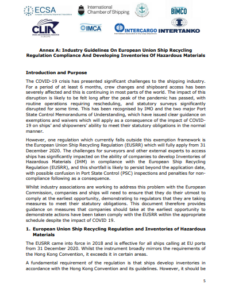Major shipping organizations and associations have jointly developed guidelines on the preparation of the Inventory of Hazardous Materials, as required by the EU Ship Recycling Regulation (EU SRR). The regulation requires all EU-flagged vessels and non EU-flagged vessels calling at any EU member state to have an IHM onboard, from 31 December 2020, and no extensions on this deadline are awaited.
Although the IMO has granted deadline waivers on several regulatory frameworks due to COVID-19 pandemic, this is not the case for the implementation of EU SRR, which will fully apply from 31 December 2020, according to the new guide signed by ECSA, CLIA, ICS, BIMCO, INTERTANKO, INTERCARGO, IMCA and ASA.
As explained, the challenges for experts to access ships has significantly impacted the ability of companies to develop IHMs in compliance with EU SRR. This shortfall is likely to persist beyond the application date, with possible confusion in PSC inspections and penalties for non-compliance following as a consequence.
Whilst industry associations are working to address this problem with the European Commission, companies and ships will need to ensure that they do their utmost to comply at the earliest opportunity, demonstrating to regulators that they are taking measures to meet their statutory obligations.
This document therefore provides guidance on measures that companies should take at the earliest opportunity to demonstrate actions have been taken in compliance with the EU SRR.
Fleet Planning
Companies should undertake the following activities at the earliest opportunity to maximize readiness of their fleet:
- Assess planned operations on the basis of the likelihood of European port calls for at least the first six months of 2021.
- Develop a strategy for the development of IHMs, prioritising those ships that will need them most urgently.
- Contact relevant flag States so as to identify their requirements with respect to timetables, and possible alternative arrangements for survey and certification.
- Contact Class Societies and IHM service providers to assess the timetable in which IHMs can be realistically developed, including possible alternative arrangements for survey and certification.
Collection of Necessary Information
The first stage of IHM development involves collection of available information on ship’s construction. This process consists of a documentation review, visual checks and, if necessary, sampling checks.
It draws on a number of potential sources such as maintenance, conversion and repair documents, certificates, manuals, ship plans and drawings, technical specifications, material declarations, and equivalent IHMs from sister ships.
It should be recognised that the availability of information about a ship will vary depending on its previous operation e.g. age, number of previous owners, number of changes of class, etc.
In some cases, Material Declarations (MD) and Supplier’s Declarations of Conformity (SDoC) forms, provided by the suppliers of parts and equipment delivered to the shipyard at construction may be available.
Assessment of Information
Once information has been collected, it should be assessed, covering all materials listed in Table A and B of Part 1 of the IHM, to identify locations where they may be present on the ship. The results of this assessment should be used to develop the visual/sampling check plan.
Preparation of Visual/Sampling Check Plan
The visual/sampling check plan should be developed on the basis of the assessment of information collected in the first step of the inventory’s development and the expertise of the person/persons developing the inventory.
While spot checks and sampling are recommended for new buildings, the visual/sampling check plan is predominantly for the development of inventories for existing ships.
It is recommended that a suitably qualified hazardous materials expert assists with the visual/sampling check plan, as this will form the basis of the on board checks and sampling of materials which will, in turn, indicate the location and approximate quantity of hazardous materials throughout the ship’s structure and equipment.
In some cases, classification societies may request approval of the visual/sampling check plan before any on board inspection or sampling is carried out.
Given the impact of COVID-19, it is likely that the onboard visual/sampling check and associated survey will be delayed due to shortfalls in the availability of qualified experts.
Explore more herebelow:


































































